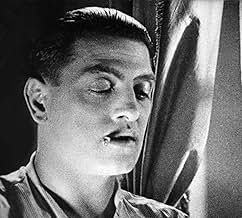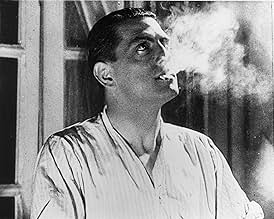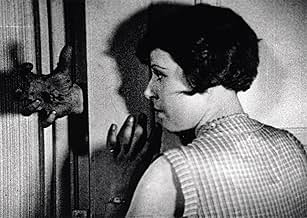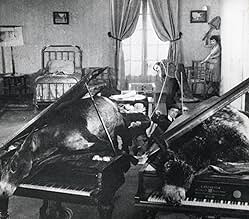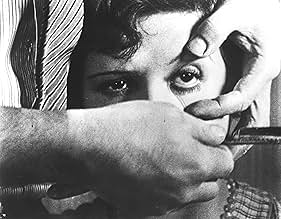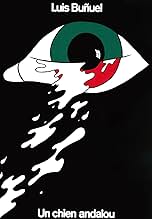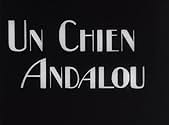IMDb-BEWERTUNG
7,6/10
55.729
IHRE BEWERTUNG
Füge eine Handlung in deiner Sprache hinzuLuis Buñuel and Salvador Dalí present 16 minutes of bizarre, surreal imagery.Luis Buñuel and Salvador Dalí present 16 minutes of bizarre, surreal imagery.Luis Buñuel and Salvador Dalí present 16 minutes of bizarre, surreal imagery.
- Regie
- Drehbuch
- Hauptbesetzung
Pierre Batcheff
- Man
- (as Pierre Batchef)
Simone Mareuil
- Young Girl
- (as Simonne Mareuil)
Luis Buñuel
- Man in Prologue
- (Nicht genannt)
Pancho Cossío
- Stroller
- (Nicht genannt)
Salvador Dalí
- Seminarist
- (Nicht genannt)
Juan Esplandiu
- Stroller
- (Nicht genannt)
Robert Hommet
- Young Man
- (Nicht genannt)
Marval
- Seminarist
- (Nicht genannt)
Fano Messan
- Hermaphrodite
- (Nicht genannt)
Jaume Miravitlles
- Fat Seminarist
- (Nicht genannt)
Empfohlene Bewertungen
Luis Buñuel and Salvador Dalí's "Un Chien Andalou" (1929) is not merely a film-it is a visceral assault on logic, a 16-minute plunge into the subconscious that redefined the boundaries of cinema. Emerging from the feverish collaboration of two avant-garde titans, this short film remains a cornerstone of surrealist art, blending dreamlike absurdity with shocking imagery to challenge the very notion of narrative coherence.
The film's structure mirrors the disjointed, irrational flow of a dream, eschewing traditional storytelling for a series of jarring vignettes. From the infamous opening scene-a cloud slicing the moon as a razor slits a woman's eyeball -to ants crawling from a man's palm and rotting donkeys draped over pianos, Buñuel and Dalí weaponize Freudian symbolism to evoke primal fears and desires. The creators famously declared that their only rule was to reject any rational explanation for the film's imagery, insisting that interpretation lies solely in the realm of psychoanalysis. This deliberate ambiguity transforms the viewer into an active participant, forced to confront their own subconscious reactions.
Shot on a shoestring budget over two weeks, the film's technical audacity remains striking. Buñuel's stark black-and-white cinematography and abrupt edits amplify the surreal atmosphere, while the use of a cow's eye for the slicing scene (to avoid harming an actor) underscores the visceral realism of the grotesque.
"Un Chien Andalou" defies categorization. It is neither a story nor a manifesto but a raw, unfiltered excavation of the human psyche. As Buñuel later quipped, "Nothing in the film symbolizes anything" , yet its power lies precisely in this refusal to conform. To watch it is to surrender to chaos-to let the ants crawl, the razors slash, and the donkeys rot. Nearly a century later, it remains a testament to art's ability to unsettle, provoke, and transcend.
A landmark of surrealism, "Un Chien Andalou" is essential viewing for anyone willing to brave its unnerving beauty. Just don't expect answers-only questions, writ large in blood and celluloid.
The film's structure mirrors the disjointed, irrational flow of a dream, eschewing traditional storytelling for a series of jarring vignettes. From the infamous opening scene-a cloud slicing the moon as a razor slits a woman's eyeball -to ants crawling from a man's palm and rotting donkeys draped over pianos, Buñuel and Dalí weaponize Freudian symbolism to evoke primal fears and desires. The creators famously declared that their only rule was to reject any rational explanation for the film's imagery, insisting that interpretation lies solely in the realm of psychoanalysis. This deliberate ambiguity transforms the viewer into an active participant, forced to confront their own subconscious reactions.
Shot on a shoestring budget over two weeks, the film's technical audacity remains striking. Buñuel's stark black-and-white cinematography and abrupt edits amplify the surreal atmosphere, while the use of a cow's eye for the slicing scene (to avoid harming an actor) underscores the visceral realism of the grotesque.
"Un Chien Andalou" defies categorization. It is neither a story nor a manifesto but a raw, unfiltered excavation of the human psyche. As Buñuel later quipped, "Nothing in the film symbolizes anything" , yet its power lies precisely in this refusal to conform. To watch it is to surrender to chaos-to let the ants crawl, the razors slash, and the donkeys rot. Nearly a century later, it remains a testament to art's ability to unsettle, provoke, and transcend.
A landmark of surrealism, "Un Chien Andalou" is essential viewing for anyone willing to brave its unnerving beauty. Just don't expect answers-only questions, writ large in blood and celluloid.
Luis Buñuel, Calanda, in the province of Teruel in the south of the region called Aragón, a town itself afamed for the twenty-four hour non-stop drums (`la tamborada') in the streets played by hundreds of people together in Holy Week, as a young man fled to Paris with the intention of doing something great in this world. There he met Salvador Dalí who had done the same, leaving his native Catalonia in his mid twenties - some five years younger than Buñuel - with more or less the same ideas in his head.
These two young men, who in later years were to be known - even admired in some cases - as the most extravagant and flamboyant creators of art, were not alone. Pablo Picasso, not yet 50, had already been blazing the trail, to mention another Spaniard among those thronging the avant-garde Paris of the times. Claude Debussy and Maurice Ravel had led the impressionist movement in music for many years, and the `Imagiste' school in poetry was well under way. Anybody who was anybody in the artistic world flocked to Paris, and either made a hit and became someone eminent, or did not.
Cinema was a new art form still to be experimented with; no wonder, then, that these two men of evidently original ideas trying to burst out of them, had to do something so as to gatecrash into the gentry of the established circles of artistes and would-be artistes or hangers-on. The Buñuel-Dalí tandem knew they would produce something different; not necessarily to scandalize anyone, but more with the purpose of attracting attention, whether from intellectuals, artists or their entrepreneurs, or just newspaper editors. Simply following the logical sequence that words can be poetic and an image is worth a thousand words, and that poetry can be abstract, thus so can images, and if they move - better still.
Buñuel got a bit of money out of his mother's purse, and thus the two young men had finance to start on making an abstract poetic sequence which did not pretend to have any logical meaning of any kind. `Un Chien Andalou' was to exist in the same way that any later painting either by Picasso or by Dalí himself would exist without necessarily purporting to mean anything, either significant or insignificant, and without necessarily any implicit objective - far less objective - raison d'etre than simply existing in itself. Whether the result could or should be considered `art' in any quintessential sense is/was up to the pundits, pseudointellectuals, newspaper critics, or anybody else who thought he had any ideas on the matter. Buñuel himself says in his autobiography `My Last Breath' that he would have quite happily burnt the film, but that would not have made any difference anyway.
`Un Chien Andalou' was the only silent film he made; whether because of lack of funds or otherwise intentionally, is hard to say. `L'Age d'Or' one year later had sound; however I cannot help thinking that Buñuel and Dali wanted to make a silent film, which then does not explain why in the 1960s Buñuel chose to add music - Wagner interspersed with a tango, a blatently at-odds combination - which would seem to have been some attempt at being unfaithful to the original. But Buñuel was nothing if not a contradictory person, to say the least. But by the 1960s he was beginning to turn out his best repertoire - `Viridiana' (qv), `Tristana', etc - and maybe his sense of maturity reigned over his other feelings, compelling him to `up-date' the film for newer audiences, even though he might be accused of unloyalty.
But, how does one remain loyal to abstract concepts which defy rationality?
Thus `Un Chien Andalou' remains one of the most misunderstood pieces of art to have ever been made public, and is perhaps the most widely-known short film of all time.
These two young men, who in later years were to be known - even admired in some cases - as the most extravagant and flamboyant creators of art, were not alone. Pablo Picasso, not yet 50, had already been blazing the trail, to mention another Spaniard among those thronging the avant-garde Paris of the times. Claude Debussy and Maurice Ravel had led the impressionist movement in music for many years, and the `Imagiste' school in poetry was well under way. Anybody who was anybody in the artistic world flocked to Paris, and either made a hit and became someone eminent, or did not.
Cinema was a new art form still to be experimented with; no wonder, then, that these two men of evidently original ideas trying to burst out of them, had to do something so as to gatecrash into the gentry of the established circles of artistes and would-be artistes or hangers-on. The Buñuel-Dalí tandem knew they would produce something different; not necessarily to scandalize anyone, but more with the purpose of attracting attention, whether from intellectuals, artists or their entrepreneurs, or just newspaper editors. Simply following the logical sequence that words can be poetic and an image is worth a thousand words, and that poetry can be abstract, thus so can images, and if they move - better still.
Buñuel got a bit of money out of his mother's purse, and thus the two young men had finance to start on making an abstract poetic sequence which did not pretend to have any logical meaning of any kind. `Un Chien Andalou' was to exist in the same way that any later painting either by Picasso or by Dalí himself would exist without necessarily purporting to mean anything, either significant or insignificant, and without necessarily any implicit objective - far less objective - raison d'etre than simply existing in itself. Whether the result could or should be considered `art' in any quintessential sense is/was up to the pundits, pseudointellectuals, newspaper critics, or anybody else who thought he had any ideas on the matter. Buñuel himself says in his autobiography `My Last Breath' that he would have quite happily burnt the film, but that would not have made any difference anyway.
`Un Chien Andalou' was the only silent film he made; whether because of lack of funds or otherwise intentionally, is hard to say. `L'Age d'Or' one year later had sound; however I cannot help thinking that Buñuel and Dali wanted to make a silent film, which then does not explain why in the 1960s Buñuel chose to add music - Wagner interspersed with a tango, a blatently at-odds combination - which would seem to have been some attempt at being unfaithful to the original. But Buñuel was nothing if not a contradictory person, to say the least. But by the 1960s he was beginning to turn out his best repertoire - `Viridiana' (qv), `Tristana', etc - and maybe his sense of maturity reigned over his other feelings, compelling him to `up-date' the film for newer audiences, even though he might be accused of unloyalty.
But, how does one remain loyal to abstract concepts which defy rationality?
Thus `Un Chien Andalou' remains one of the most misunderstood pieces of art to have ever been made public, and is perhaps the most widely-known short film of all time.
This famous film starts in a dream-like sequence, a woman's eye (a cow's eye was actually used) is slit open and juxtaposed with a similarly shaped cloud obscuring . After that , there take place several bizarre events such as a man has a hole in the palm from which ants emerge , it is shown literally ; later on , a man pulls a piano along with the tablets of the Ten Commandments and a dead donkey and two priests being dragged with the piano (a priest is Salvador Dalí) ; a woman pokes at a severed hand in the street with his cane (legend has it that the severed hand used in the street scene was a real hand, and Dali convinced a man to cut it off in exchange for enough money to buy lunch) , among others .
Abstract film that marked strong polemic in the epoch when it was realised , especially its sliced eyeball at the beginning , and still packs a punch even nowadays . In fact , at the Paris premiere, Luis Buñuel hid behind the screen with stones in his pockets for fear of being attacked by the confused audience . After editing the feature , Luis Buñuel and Salvador Dalí didn't know what to do with it , as an acquaintance introduced Buñuel to Man Ray, who had just finished Les Mystères du château Dé and was looking for a second film to complete the program , the two movies premiered together at the Studio Ursulines ; it made a deep impression on the Surrealist Group, who welcomed Buñuel into their ranks . The movie contains several references to Federico García Lorca and other writers of that time . The rotting donkeys are a reference to the novel "Platero y yo" by Juan Ramón Jiménez, which Luis Buñuel and Dalí hated . In 1960, a soundtrack was added to this film at the direction of Luis Buñuel , he used the same music which was played , using phonograph records , at the 1929 screenings-extracts from "Liebestod" from Richard Wagner's "Tristan and Isolde" and two Argentinian tangos.
This rare short belongs to Luis Buñuel's first period and has been voted as one of "The 25 Most Dangerous Movies" . After moving to Paris , Buñuel did a variety of film-related odd jobs , including working as an assistant to director Jean Epstein . With financial help from his mother and creative assistance from Dalí, he made his first film , this 17-minute "Un Chien Andalou" (1929), and immediately catapulted himself into film history thanks to its disturbing images and surrealist plot . The following year , sponsored by wealthy art patrons, he made his first picture , the scabrous witty and violent "Age of Gold" (1930), which mercilessly attacked the church and the middle classes, themes that would preoccupy Buñuel for the rest of his career . That career, though, seemed almost over by the mid-1930s, as he found work increasingly hard to come by and after the Spanish Civil War , where he made ¨Las Hurdes¨ , as Luis emigrated to the US where he worked for the Museum of Modern Art and as a film dubber for Warner Bros . He subsequently went on his Mexican period with "The Great Madcap" , ¨Los Olvidados¨ , ¨The brute¨, "Wuthering Heights", ¨El¨ , "The Criminal Life of Archibaldo De la Cruz" , ¨Robinson Crusoe¨ and many others . And finally his French-Spanish period with notorious as well as polemic films such as ¨Viridiana¨ , Tristana¨ , ¨The Discreet Charm of the Bourgeoisie" and his last picture , "That Obscure Object of Desire" .
Abstract film that marked strong polemic in the epoch when it was realised , especially its sliced eyeball at the beginning , and still packs a punch even nowadays . In fact , at the Paris premiere, Luis Buñuel hid behind the screen with stones in his pockets for fear of being attacked by the confused audience . After editing the feature , Luis Buñuel and Salvador Dalí didn't know what to do with it , as an acquaintance introduced Buñuel to Man Ray, who had just finished Les Mystères du château Dé and was looking for a second film to complete the program , the two movies premiered together at the Studio Ursulines ; it made a deep impression on the Surrealist Group, who welcomed Buñuel into their ranks . The movie contains several references to Federico García Lorca and other writers of that time . The rotting donkeys are a reference to the novel "Platero y yo" by Juan Ramón Jiménez, which Luis Buñuel and Dalí hated . In 1960, a soundtrack was added to this film at the direction of Luis Buñuel , he used the same music which was played , using phonograph records , at the 1929 screenings-extracts from "Liebestod" from Richard Wagner's "Tristan and Isolde" and two Argentinian tangos.
This rare short belongs to Luis Buñuel's first period and has been voted as one of "The 25 Most Dangerous Movies" . After moving to Paris , Buñuel did a variety of film-related odd jobs , including working as an assistant to director Jean Epstein . With financial help from his mother and creative assistance from Dalí, he made his first film , this 17-minute "Un Chien Andalou" (1929), and immediately catapulted himself into film history thanks to its disturbing images and surrealist plot . The following year , sponsored by wealthy art patrons, he made his first picture , the scabrous witty and violent "Age of Gold" (1930), which mercilessly attacked the church and the middle classes, themes that would preoccupy Buñuel for the rest of his career . That career, though, seemed almost over by the mid-1930s, as he found work increasingly hard to come by and after the Spanish Civil War , where he made ¨Las Hurdes¨ , as Luis emigrated to the US where he worked for the Museum of Modern Art and as a film dubber for Warner Bros . He subsequently went on his Mexican period with "The Great Madcap" , ¨Los Olvidados¨ , ¨The brute¨, "Wuthering Heights", ¨El¨ , "The Criminal Life of Archibaldo De la Cruz" , ¨Robinson Crusoe¨ and many others . And finally his French-Spanish period with notorious as well as polemic films such as ¨Viridiana¨ , Tristana¨ , ¨The Discreet Charm of the Bourgeoisie" and his last picture , "That Obscure Object of Desire" .
this movie may be dated in a certain sense, but the vitality and passion of its vicious rebellion against societal taboos and constraints still comes through full throttle. bunuel, master of cinematic/surrealist revolt, violates every boundary he can think of. a woman's eyeball is slashed open, her chest brutally groped, ants crawl out of a man's hand, etc. this is more of a curiosity than anything else, but I am a surrealism fanatic and love this along with Cocteau's "Blood of a Poet". the reviewers here who downplay it's value are simply wrong and probably decided in advance to dislike it to look different.
Even those who do not like Buñuel's "Un Chien Andalou" will probably never forget it once they see it. It's one of the weirder and more interesting films that you'll ever run across, and even aside from its significance, it would be worth seeing for the distinctive style and material.
It is also very well-crafted, despite its apparently chaotic narrative (or lack thereof). Even when it is impossible to attach meaning to some of the images, it seems clear that it has been filmed almost exactly as Buñuel and Dali intended. Even the music seems to have been chosen deliberately, and at times it complements the images surprisingly well.
While the exact meanings of many of the symbols are probably deliberately obscure, it strongly suggests some general themes such as desire, frustration, and the like. To attempt to analyze it carefully is almost certainly a mistake, and it is probably best taken as a dream or a dream-like series of events without the kinds of obvious connections that one might want to find.
Likewise, it's hard to determine just how good or how important it may be. The extreme disregard of cinema conventions is hard to evaluate now, in that the movie itself established some alternative conventions of a sort. The images themselves are often fascinating, sometimes unsettling or even off-putting, almost always interesting and suggestive.
Perhaps the one thing that can be said about such a movie without much risk of going astray is that almost anyone who has a real interest in cinema or cinema history will (or ought to) want to see "Un Chien Andalou" for himself or herself. Hearing it described by someone else really cannot adequately convey what it is like.
It is also very well-crafted, despite its apparently chaotic narrative (or lack thereof). Even when it is impossible to attach meaning to some of the images, it seems clear that it has been filmed almost exactly as Buñuel and Dali intended. Even the music seems to have been chosen deliberately, and at times it complements the images surprisingly well.
While the exact meanings of many of the symbols are probably deliberately obscure, it strongly suggests some general themes such as desire, frustration, and the like. To attempt to analyze it carefully is almost certainly a mistake, and it is probably best taken as a dream or a dream-like series of events without the kinds of obvious connections that one might want to find.
Likewise, it's hard to determine just how good or how important it may be. The extreme disregard of cinema conventions is hard to evaluate now, in that the movie itself established some alternative conventions of a sort. The images themselves are often fascinating, sometimes unsettling or even off-putting, almost always interesting and suggestive.
Perhaps the one thing that can be said about such a movie without much risk of going astray is that almost anyone who has a real interest in cinema or cinema history will (or ought to) want to see "Un Chien Andalou" for himself or herself. Hearing it described by someone else really cannot adequately convey what it is like.
Wusstest du schon
- WissenswertesAt the Paris premiere, Luis Buñuel hid behind the screen with stones in his pockets for fear of being attacked by the confused audience. Nothing of the sort happened. In fact, the audience loved its mysterious and incomprehensible plot.
- Alternative VersionenThe film was re-released in 1960 with soundtracks.
- VerbindungenEdited into Avant-garde Cinema (1960)
Top-Auswahl
Melde dich zum Bewerten an und greife auf die Watchlist für personalisierte Empfehlungen zu.
Details
- Erscheinungsdatum
- Herkunftsland
- Sprache
- Auch bekannt als
- Der andalusische Hund
- Drehorte
- Weitere beteiligte Unternehmen bei IMDbPro anzeigen
- Laufzeit
- 16 Min.
- Farbe
- Sound-Mix
- Seitenverhältnis
- 1.33 : 1
Zu dieser Seite beitragen
Bearbeitung vorschlagen oder fehlenden Inhalt hinzufügen


